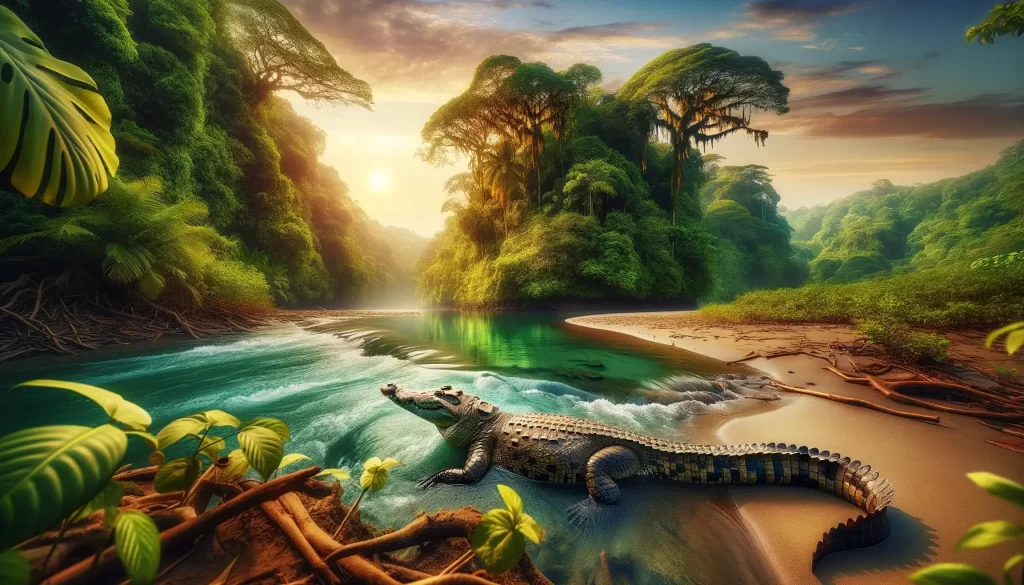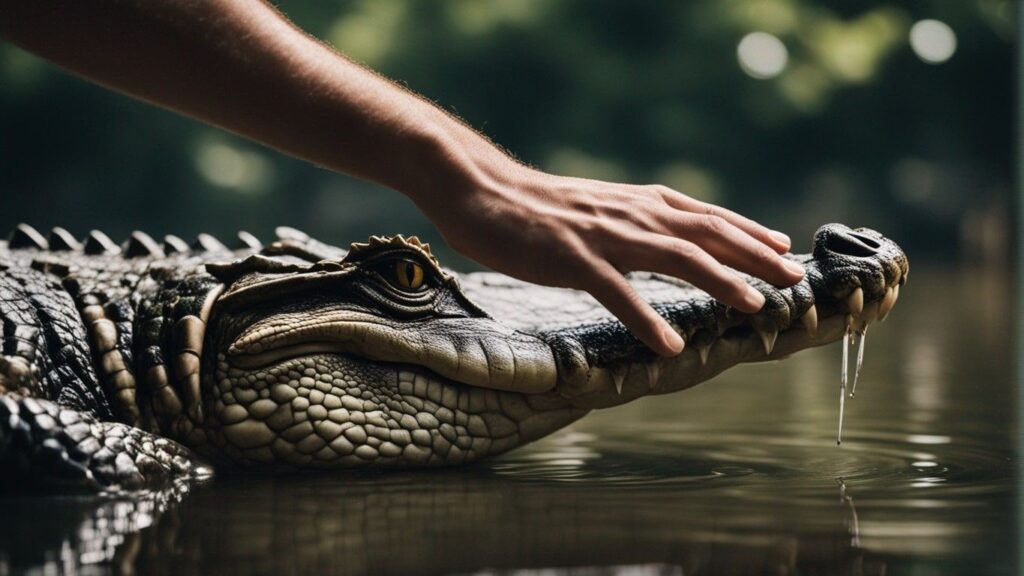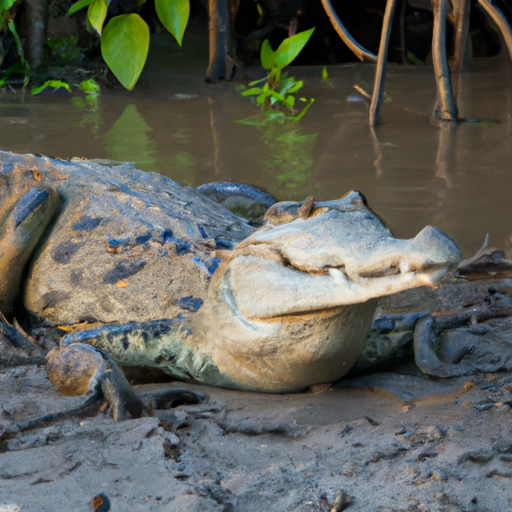
Picture yourself strolling along the pristine shores of Costa Rica, the warm sand cushioning each step.
The crashing waves serenade your ears while the vibrant tropical foliage dances in the breeze.
But amidst this paradise lies a hidden danger lurking in the turquoise waters – crocodiles.
In this article, you will discover effective tips and strategies to ensure your safety and avoid any unexpected encounters with these formidable creatures while exploring the enchanting landscapes of Costa Rica.
So, grab your sun hat and let’s embark on a thrilling adventure filled with knowledge and caution.
Understanding the Crocodile Situation in Costa Rica
Costa Rica is known for its rich biodiversity and stunning natural landscapes, but it is also home to various species of crocodiles. Understanding the different types of crocodile species in Costa Rica is essential for ensuring your safety during your visit.
Types of crocodile species in Costa Rica
In Costa Rica, two species of crocodiles can be found: the American Crocodile (Crocodylus acutus) and the Spectacled Caiman (Caiman crocodilus). The American Crocodile is the larger of the two, reaching lengths of up to 20 feet, whereas the Spectacled Caiman is smaller, generally growing to about 6 feet in length. Both species are known for their powerful jaws and predatory nature.
Distribution and habitats of crocodiles in Costa Rica
Crocodiles in Costa Rica are primarily found along the country’s Pacific coast, as well as in certain inland regions. They inhabit a variety of habitats, including mangrove swamps, river mouths, estuaries, and even some freshwater lakes. It’s important to note that crocodiles do not typically venture into higher elevations or mountainous areas, so most encounters occur in low-lying coastal regions.
Understanding crocodile behavior and risks
Crocodiles are naturally cautious and elusive creatures, but it is crucial to be aware of the potential risks they pose. While the vast majority of crocodile encounters in Costa Rica are non-threatening, it is essential to exercise caution and respect their natural behaviors. Crocodiles are most active during the early morning and late afternoon, and they may become more aggressive during breeding seasons or when defending their territory. It’s also important to understand that crocodiles are excellent swimmers and can move swiftly on land, making it essential to maintain a safe distance at all times.
Researching Crocodile-Free Areas in Costa Rica
To ensure your safety and peace of mind, it is worth researching and identifying crocodile-free areas when planning your visit to Costa Rica. By focusing on areas that are known to have minimal or no crocodile presence, you can enjoy your time in nature without unnecessary concerns.
Identifying crocodile-free beaches
Costa Rica boasts numerous stunning beaches, and while many of them do have crocodile populations nearby, there are still some that are considered relatively safe and free from their presence. Popular crocodile-free beaches include Manuel Antonio Beach, Playa Flamingo, and Playa Tamarindo, among others. These beaches offer beautiful landscapes, crystal-clear waters, and a reduced risk of encountering crocodiles.
Exploring crocodile-free rivers and lakes
If you’re interested in exploring inland water bodies, such as rivers and lakes, it’s essential to choose those that are known to be crocodile-free. The Tenorio River, for example, is a popular destination for whitewater rafting and boasts a negligible crocodile presence. Similarly, Lake Arenal is a prime spot for kayaking and fishing without the worry of encountering crocodiles.
Recommended parks and nature reserves without crocodiles
Costa Rica is renowned for its national parks and protected areas, many of which offer incredible wildlife experiences without the presence of crocodiles. Parks like Monte Verde Cloud Forest Reserve, Arenal Volcano National Park, and Corcovado National Park provide opportunities to explore diverse ecosystems and observe Costa Rica’s captivating biodiversity up close, without the concern of crocodile encounters.
Choosing Safe Accommodations
While selecting accommodations for your stay in Costa Rica, it’s crucial to consider their proximity to crocodile habitats and secure features that can minimize any potential risks.
Selecting hotels and resorts away from crocodile habitats
To minimize the chances of encountering crocodiles during your stay, opt for hotels and resorts located away from known crocodile habitats. Researching the specific location of your chosen accommodation can help you make informed decisions. Popular tourist destinations like Manuel Antonio, Tamarindo, and Jaco offer a variety of accommodations that are situated in safe areas where crocodile sightings are highly unlikely.
Inspecting accommodations for potential crocodile entry points
When evaluating potential accommodations, it’s essential to inspect the premises for any potential entry points that could allow crocodiles to access the area. This includes checking for gaps under doors, open windows, or easy access to water bodies where crocodiles may inhabit. Inquire with the hotel staff about their safety measures and any steps they take to ensure the premises remain crocodile-free.
Considering elevated accommodations near water bodies
Opting for accommodations that are elevated and situated at a safe distance from water bodies can offer an added layer of security. Elevated structures, such as treehouses or lodges built on stilts, provide a physical barrier that significantly reduces the risk of crocodile encounters. Many eco-lodges and resorts in Costa Rica offer elevated options, allowing you to enjoy your surroundings while minimizing any potential risks.

Understanding Crocodile Behavior and Warning Signs
Equipping yourself with knowledge about crocodile behavior and the warning signs of their presence can significantly contribute to your safety during your stay in Costa Rica.
Learning about crocodile feeding patterns and activity times
Crocodiles are most active during the early morning and late afternoon when they prefer to hunt for food. Being aware of their feeding patterns can help you plan your activities accordingly, avoiding areas where crocodile activity is likely to be higher. It’s important to note that crocodiles are opportunistic feeders and may be attracted to areas where there are abundant prey, such as fish or nesting birds.
Recognizing warning signs of crocodile presence
Crocodiles are known to be excellent at blending into their surroundings and are skilled at camouflage. However, there are still signs that can give away their presence. Look out for their eyes and snouts protruding above the water’s surface, as well as signs of disturbed water along river banks or shorelines. Pay attention to local signs and warnings, as they may indicate areas where crocodile sightings have occurred recently.
Understanding crocodile hiding spots and camouflage techniques
Crocodiles are masters of hiding, and they often seek shelter in areas with dense vegetation or underwater structures. Mangrove forests, for instance, provide an ideal hiding spot for crocodiles due to their intricate root systems. Be cautious when navigating areas with dense vegetation, and avoid swimming or wading in waters where crocodiles may be hiding. Additionally, be mindful of submerged logs or rocks that can serve as hiding places for crocodiles.
Safely Enjoying Costa Rica’s Water Activities
Costa Rica’s abundant water bodies offer countless opportunities for water-based activities, including swimming, snorkeling, surfing, and boating. By selecting popular destinations known to be crocodile-free and adhering to safety protocols, you can enjoy these activities while minimizing any potential risks.
Choosing popular water destinations known to be crocodile-free
To enjoy water activities without worrying about encountering crocodiles, consider visiting popular destinations that have been deemed crocodile-free. Beaches like Playa Hermosa, Santa Teresa, and Playa Grande are known for their safe swimming conditions and minimal crocodile presence. These areas attract a significant number of tourists who enjoy water sports and activities with peace of mind.
Participating in water activities with experienced guides
When engaging in water activities such as snorkeling or boating, it’s recommended to do so with experienced guides who are knowledgeable about local conditions and potential risks. These guides can provide valuable insights, ensuring that you enjoy your activities safely and responsibly. Local guides are familiar with the areas they operate in and can help you steer clear of areas where crocodile encounters are more likely.
Following safety protocols and guidelines for swimming and boating
Whether you’re swimming, snorkeling, or engaging in boating activities, following safety protocols and guidelines is crucial. Always swim in designated areas and avoid venturing too far from the shore. Keep an eye out for warning signs or flags that may indicate unsafe conditions or the presence of crocodiles. When boating, maintain a safe distance from shorelines or any known crocodile habitats. Remember to wear a life jacket and be aware of your surroundings at all times.
Minimizing Risks While Exploring Mangrove Forests
The enchanting mangrove forests of Costa Rica offer unique opportunities for nature exploration, but they are also known to be habitats for crocodiles. By taking necessary precautions and joining guided tours, you can safely navigate these areas.
Joining guided tours to navigate crocodile-inhabited mangrove forests
Exploring mangrove forests with experienced guides can significantly enhance your safety and knowledge about crocodile-inhabited areas. These guides are well-versed in the behavior and habitats of crocodiles, ensuring that you can enjoy a fascinating experience without compromising your safety. They know which routes to take and can provide valuable insights into the flora and fauna of the mangrove ecosystem.
Avoiding swimming or wading in mangrove areas
While it may be tempting to take a refreshing swim or wade through the calm waters of mangrove areas, it’s important to resist the urge. These regions are known crocodile habitats, and entering the water can put you at risk of a potentially dangerous encounter. Instead, focus on observing the unique wildlife and lush vegetation from the safety of a boat or designated viewing platforms.
Taking precautions when photographing or observing crocodiles
If you’re an avid wildlife photographer or simply enjoy observing crocodiles in their natural habitat, it’s crucial to do so responsibly and safely. Always maintain a safe distance from the crocodile, using zoom lenses or binoculars to get a close-up view. Avoid sudden movements, as they may startle the crocodile, and remember that the flash of a camera may irritate or provoke the animal. Respect their space and enjoy observing them from a safe distance.
Interacting with Wildlife Responsibly
One of the joys of visiting Costa Rica is witnessing its incredible wildlife. When encountering crocodiles or any other wildlife, it’s important to interact responsibly, ensuring the well-being of the animals and the preservation of their natural habitats.
Adhering to regulations for feeding wildlife
Feeding wildlife, including crocodiles, can have detrimental effects on their behavior and disrupt their natural feeding patterns. It’s important to adhere to regulations and avoid feeding wildlife in any circumstance. Feeding crocodiles can lead to dependence on humans as a food source, increasing the risks of dangerous encounters. Enjoy observing these majestic creatures in their natural state, but do not attempt to interfere with their feeding habits.
Maintaining a safe distance when observing crocodiles
When observing crocodiles, always maintain a safe distance to avoid any potential risks. Respect the natural boundaries of the animal’s habitat and refrain from approaching them closely. Remember that crocodiles are wild animals and should be observed from a distance that ensures your safety while allowing you to appreciate their beauty and behavior. Keep in mind that getting too close can disturb and stress the animal, potentially leading to aggressive behavior.
Understanding the importance of preserving natural habitats
Preserving natural habitats is crucial for the long-term survival of crocodiles and the diverse ecosystems in which they reside. When visiting Costa Rica or any other natural destination, it’s essential to respect the environment and be mindful of your impact. Avoid littering, stay on designated trails, and follow the principles of leave-no-trace. By adopting responsible and sustainable practices as visitors, we can contribute to the conservation efforts and protect the habitats of crocodiles and other wildlife species.
Educating Yourself on Local Crocodile Safety Tips
To stay informed and prepared during your visit to Costa Rica, educating yourself on local crocodile safety tips is essential. Local authorities, experts, and workshops can provide valuable insights and knowledge to help you navigate safely in crocodile-inhabited areas.
Seeking advice from local authorities and experts
Local authorities, such as national park rangers or conservation organizations, are valuable sources of information regarding crocodile safety. They can provide you with the latest updates on crocodile behavior or any recent incidents in the area. Reach out to them for advice and guidelines specific to your desired destination, as they often possess extensive knowledge and experience working with crocodile populations.
Attending educational workshops or presentations on crocodile safety
Educational workshops or presentations focused on crocodile safety can equip you with the necessary knowledge to make informed decisions during your visit to Costa Rica. These sessions are often led by experts who share insights into crocodile behavior, safer practices, and what to do in case of an encounter. Participating in these educational events can significantly enhance your understanding and awareness, allowing you to enjoy your time in Costa Rica with greater confidence.
Staying updated on recent crocodile incidents or changes in behavior
Crocodile behavior can change over time, affected by factors such as weather patterns, habitat alterations, or human interactions. It is important to stay updated on any recent crocodile incidents or changes in their behavior that may affect your visit. Local news outlets, wildlife conservation organizations, or online forums can provide valuable information and insights on current trends or occurrences related to crocodiles in Costa Rica.
Being Prepared for Emergencies
While the likelihood of a crocodile encounter is rare, it is still crucial to be prepared for emergencies and know how to respond appropriately. Being knowledgeable about first aid techniques and having a plan in place can make all the difference in potentially dangerous situations.
Knowing proper first aid techniques for crocodile encounters
In the event of a crocodile encounter, it’s crucial to know the correct first aid techniques to minimize the risk of further injury. Remember that prevention is key, and maintaining a safe distance from the animal is the best approach. However, in the unlikely event of an attack, knowing how to control bleeding, immobilize injured limbs, or perform CPR can be lifesaving. Familiarize yourself with first aid procedures specific to animal attacks, and consider taking a first aid course before your trip.
Carrying a safety whistle or device to deter crocodile attacks
As an additional safety measure, carrying a safety whistle or device specifically designed to deter crocodile attacks can provide peace of mind during your visit. These devices emit high-frequency sounds that can startle and deter crocodiles, potentially averting an attack. While encounters are rare, having such a device readily available can give you an added sense of security.
Creating an emergency plan and informing others about your activities
Before embarking on any outdoor adventure, it’s essential to create an emergency plan and inform others about your activities. Let someone trustworthy know your itinerary, including the areas you plan to visit and the estimated duration of your trip. Ensure that they are aware of any potential risks or concerns, such as crocodile habitats, and arrange check-in times to confirm your safety. Having a well-communicated emergency plan is crucial in the event of any unforeseen circumstances.
Promoting Crocodile Conservation Efforts
Supporting crocodile conservation efforts is instrumental in ensuring the long-term survival of these fascinating creatures. By actively participating in initiatives and spreading awareness about the importance of coexisting with crocodiles, we can contribute to their preservation.
Supporting organizations focused on crocodile conservation
Numerous organizations in Costa Rica dedicate their efforts to conserve and protect crocodile populations and their habitats. Consider supporting these organizations through donations or volunteer work. By contributing to their initiatives, you directly contribute to the conservation and preservation of crocodile habitats, ensuring a sustainable future for these incredible creatures.
Participating in citizen science initiatives to monitor crocodile populations
Citizen science initiatives provide opportunities for individuals to actively participate in research and monitoring of crocodile populations. By joining these initiatives, you can help collect valuable data on crocodile behavior, population trends, and habitat usage. Contributing to scientific studies in this manner enhances our understanding of crocodile ecology and supports conservation efforts.
Educating others about the importance of coexisting with crocodiles
Spreading awareness about the importance of coexisting with crocodiles is vital in promoting their conservation. Educate others about the critical role crocodiles play in maintaining healthy ecosystems and the need to respect their habitats. By sharing knowledge about crocodile behavior, safety tips, and conservation efforts, you inspire others to appreciate and protect these magnificent creatures.
Final Thoughts
By following these comprehensive guidelines, you can enjoy your time in Costa Rica while minimizing the risks associated with crocodile encounters.
Understanding their behavior, choosing safe locations and accommodations, and maintaining a responsible approach to wildlife interaction will ensure a memorable and safe visit to this beautiful country.
Remember, by promoting crocodile conservation efforts and respecting their habitats, we contribute to their preservation for generations to come.



